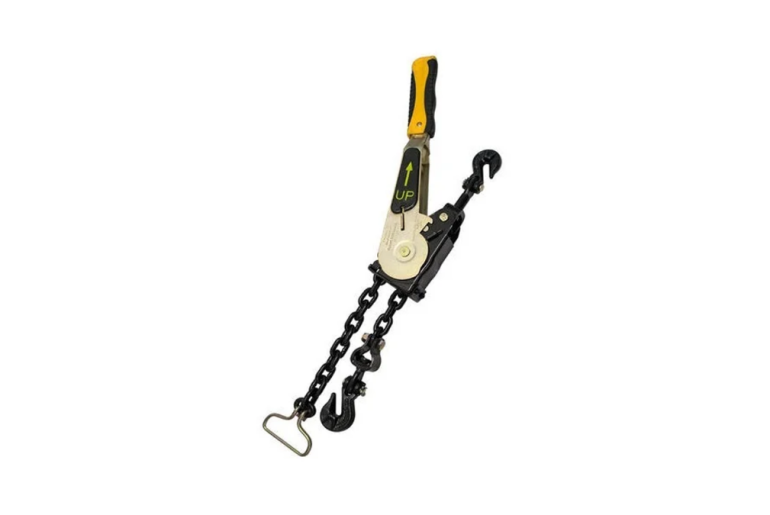Do you need to transport an unusually heavy load? Are you not sure if your regular tie-downs will be strong enough to keep your cargo secure? It may be time to reach for the chains and the chain binder tool.
One of the more effective ways to transport everything from heavy machinery to aeroplanes and everything in between is by using the right chains. Since chains can’t effectively be tied by hand, you will need to use a maxibinder to secure the load.
What is a Maxibinder?
If you’ve never used chains to transport anything, you may not be familiar with maxibinders and how they work. Simply put, a maxibinder is a binder tool that allows you to tighten and secure chains over a load.
Maxibinders are made with an ergonomic rubber handle and an enclosed locking mechanism that, when used correctly, can prevent slack tensioning during transport. This ergonomical tool’s popularity has skyrocketed in the transport industry and many chalk it down to its simplicity and ease of use.
Some of the features that make this binder standout include the following:
- Designed and manufactured according to stringent Australian standards (AS/NZS 4344)
- Durable for higher pre-tensioning strength
- Practical, ergonomic design
- Made from alloy steel
- Heat treated for durability
- 1/8 chain link length adjustment
Use a Maxibinder for Safe and Efficient Load Restraint
Business owners and drivers have a responsibility to ensure that loads are secured properly before transit. With this in mind, it’s essential to know how to use your tie-down equipment safely.
This will not only ensure the safety of everyone on the road but will also prevent the transporter from getting a severe fine for unsafe transporting.
To help you with this, our experts have compiled a list of factors to know and tips to help you successfully use a maxibinder for your next heavy-duty haul.
1. Understand the Challenges of Heavy-Duty Hauling
The first step in preparing for your heavy -duty transport is to understand what challenges you’ll be facing. For starters, transporting exceptionally heavy loads such as machinery poses its own unique challenges as a result of weight, size, and of course, the complexity of the road.
Keep in mind that moving a very large or heavy piece of machinery causes extensive vibrations during transit. This, in turn, causes the equipment to slide around, shift, and if not tied down correctly, even tip over. Therefore, effective load restraint is critical.
2. Know How to Inspect Your Chain and Maxibinder Before Use
Inspecting your chain and maxibinder is as critical as checking material straps and regular ratchets. Just because these items are heavy-duty, doesn’t mean they can’t be damaged or weak. Here’s how you should inspect both the chain and the maxibinder you’re going to use.
Always check the chain for the following:
- Cracks, breaks, or weak links
- Potential heat damage
- Excessive corrosion
- Stretched or elongated chain links
- Excessive wear and tear
Inspect your maxibinder in the following ways:
- Check the mechanism for soil or dirt to prevent the binder from getting jammed.
- Yank the chain in both directions to ensure that the chain wheel revolves freely – you may need to lower the handle so that the binder is in a freewheel position.
- Inspect the operation of the ratchet mechanism and stop plate by lifting the control plate and sliding the handle towards the front.
- The handle also boasts a built-in safety lock mechanism. Be aware that this mechanism securely locks the handle in a firm position so that the pawl doesn’t release as a result of shackling go vibration.
3. Using the Maxibinder is Easier Than You Think
First-time users will be delighted to learn that using the maxibinder is easier than first anticipated. We’ve created a simple explanation of the process that will have you using your maxibinder like a pro in no time. Simply follow these steps to tension your maxibinder:
- Step 1: Always start the tensioning process by putting the handle in the upright, finished position. This is most commonly referred to as “stowing”.
- Step 2: Double-check that the binding chain isn’t twisted when you attach the maxibinder’s top hook to it.
- Step 3: Once the top hook is connected, pull the control plate out.
- Step 4: Push the handle to the very end to lock the maxibinder in the freewheel position.
- Step 5: Fully remove the chain from the binder and then connect the bottom hook to the binding chain.
- Step 6: Pull the control plate one last time. Move the handle up and down to start tensioning.
- Step 7: Once the ratcheting is complete, ensure that the handle is upright, and the safety lock is securely engaged.
Final Thoughts
Using the right tools and equipment to transport your heavy-duty load is essential to ensuring overall safety. The use of chains and a maxibinder are by far the most effective way of doing this. Effectively implementing our tips and guidelines will give you peace of mind that your load will be secure, no matter how long or short the journey is!

